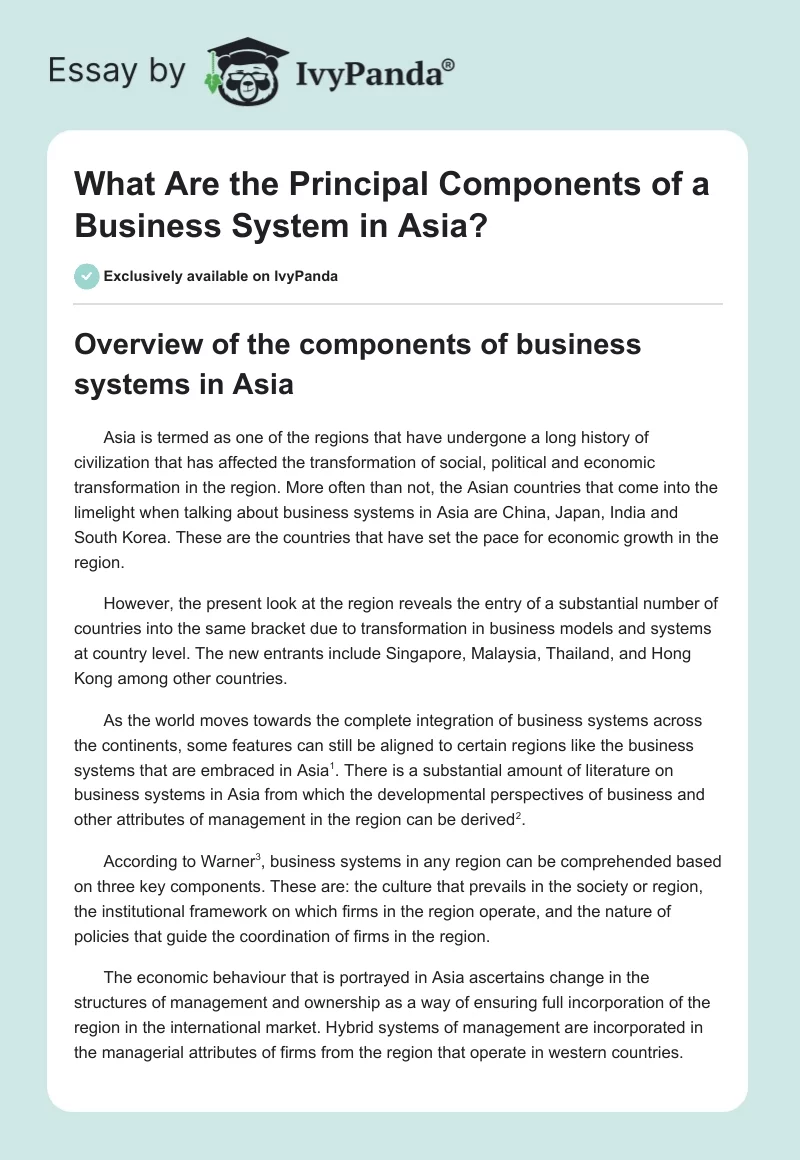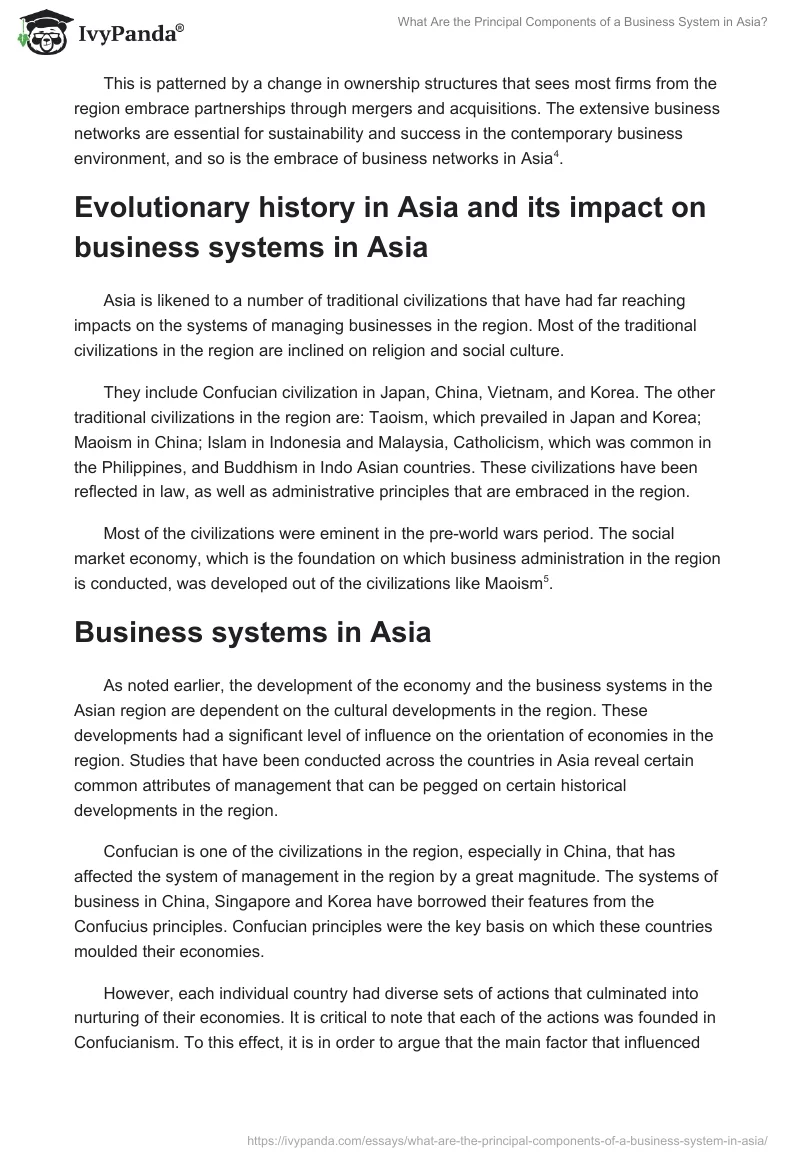Overview of the components of business systems in Asia
Asia is termed as one of the regions that have undergone a long history of civilization that has affected the transformation of social, political and economic transformation in the region. More often than not, the Asian countries that come into the limelight when talking about business systems in Asia are China, Japan, India and South Korea. These are the countries that have set the pace for economic growth in the region.
However, the present look at the region reveals the entry of a substantial number of countries into the same bracket due to transformation in business models and systems at country level. The new entrants include Singapore, Malaysia, Thailand, and Hong Kong among other countries.
As the world moves towards the complete integration of business systems across the continents, some features can still be aligned to certain regions like the business systems that are embraced in Asia. There is a substantial amount of literature on business systems in Asia from which the developmental perspectives of business and other attributes of management in the region can be derived.
According to Warner, business systems in any region can be comprehended based on three key components. These are: the culture that prevails in the society or region, the institutional framework on which firms in the region operate, and the nature of policies that guide the coordination of firms in the region.
The economic behaviour that is portrayed in Asia ascertains change in the structures of management and ownership as a way of ensuring full incorporation of the region in the international market. Hybrid systems of management are incorporated in the managerial attributes of firms from the region that operate in western countries. This is patterned by a change in ownership structures that sees most firms from the region embrace partnerships through mergers and acquisitions. The extensive business networks are essential for sustainability and success in the contemporary business environment, and so is the embrace of business networks in Asia.
Evolutionary history in Asia and its impact on business systems in Asia
Asia is likened to a number of traditional civilizations that have had far reaching impacts on the systems of managing businesses in the region. Most of the traditional civilizations in the region are inclined on religion and social culture.
They include Confucian civilization in Japan, China, Vietnam, and Korea. The other traditional civilizations in the region are: Taoism, which prevailed in Japan and Korea; Maoism in China; Islam in Indonesia and Malaysia, Catholicism, which was common in the Philippines, and Buddhism in Indo Asian countries. These civilizations have been reflected in law, as well as administrative principles that are embraced in the region.
Most of the civilizations were eminent in the pre-world wars period. The social market economy, which is the foundation on which business administration in the region is conducted, was developed out of the civilizations like Maoism.
Business systems in Asia
As noted earlier, the development of the economy and the business systems in the Asian region are dependent on the cultural developments in the region. These developments had a significant level of influence on the orientation of economies in the region. Studies that have been conducted across the countries in Asia reveal certain common attributes of management that can be pegged on certain historical developments in the region.
Confucian is one of the civilizations in the region, especially in China, that has affected the system of management in the region by a great magnitude. The systems of business in China, Singapore and Korea have borrowed their features from the Confucius principles. Confucian principles were the key basis on which these countries moulded their economies.
However, each individual country had diverse sets of actions that culminated into nurturing of their economies. It is critical to note that each of the actions was founded in Confucianism. To this effect, it is in order to argue that the main factor that influenced the modelling of the economies and business systems in the three countries is Confucianism.
One of the attributes of management that is synonymous with business management in these countries is centralization in decision making. Centralization is associated with the social market structure. Government policies are greatly embraced in shaping different functionalities in the economy, rather that the embrace of an open market economy where market forces are the main determinants of the direction that is taken in business management.
An excavation into the history of economic transformation in the three countries reveals the development of a series of plans by governments. These economic plans had far reaching impacts on the structures of the economies and systems of managing in the region. The main components of the plans were the incremental development of the economies through development of infrastructure and human capital.
Examples are the five year economic plans that were rolled by the Korean government. In Singapore, a lot of emphasis has been put on the education system as a source of skills and competencies that are vital for economic transformation.
Therefore, financing the education sector by the government of Singapore is a key component of the economic plans that aid in improving the economy by providing the desirable skills and competency that are required in adept management. The same case also applies to China, where formal and informal education systems have been developed and embraced by the government.
This is the reason why the country records a higher number of skilled employees amongst its population. These governments have higher levels of monopoly on skills, which are critical to management and economic transformation.
Components of the modern business systems in Asia
According to Redding, Bondn and Witt, the contemporary business environment in Asia reveals that a lot of changes have been adopted in the structure of business systems in the region. Part of the change is attributed to the integration of these regions into the international business system. This has necessitated adoption of various forms of management that differ from the traditional forms of management that were embraced in the region. According to the research that has been conducted in the recent times, a number of changes have been made to the structures of management that used to be embraced in management in the Asian countries.
This denotes a tendency to refrain from deeper attributes of culture due to the need to embrace cross-cultural issues in management due to the prevalence and growth of a globalized business environment.
According to Redding, the current business environment is most Asian countries, among them China, denotes the effort by business managers to secede from aspects of culture that are impediments to incorporation of firms from these countries into the global market. Some of the mechanisms that are deployed by these countries include strategies of adaptation in the global business environment like language learning.
According to Witt and Redding, there has been a significant change in the manner in which firms approach the issue of corporate social responsibility by firms. Just like it is highly embraced in western firms, firms from the Asian region have also been forced to embrace corporate social responsibility.
However, the level of conceptualization of corporate social responsibility among a substantial number of executives from the Asian region is still far much lower compared to their western counterparts. This observation is in relation to comparative environment that forms the modern basis on which the analyses and assessment of business systems across regions is done.
What comes out of contemporary research is that executives from the Asian region are realizing that corporate social responsibility is a valuable component of the modern business, thus they are moving away from the cultural antecedents of management that has been an impediment to the adoption of corporate social functions in business management.
Lawler and Atmiyanandana established that accumulation and abundance of human resource has been one of the strategies through which the Asian countries have thrived in business. To add to that, there has been a substantial amount of investment in human capital development in countries like Thailand, Singapore and Malaysia by observing contemporary practices in human resource management.
The changes are not only prevalent at the local level, but they also prevail in multinationals that are mothered by these countries. This is an indicator of migration from the traditional socialist forms of capital management that were copied from countries like China and Japan. This is an important move that is making Asian corporations competitively in the global scene.
The other important factor that is revealed by researchers, which is perhaps the summative factor in aspects of business management and business systems in Asia, revolves around adoption of aspects of capitalism in the management of firms and institutions by the Asian countries.
Unlike in the ancient times, business organizations in Asia are increasingly adopting human capital practices in management. This is meant to increase the level of order in the discharge of business functions as witnessed in most western organizations, which feature three critical aspects to attain order. These are real capital, human capital and social capital. Technology is one of considerations and it acts as one of the competitive strengths of most firms that are emerging in Asia. With the embrace of human resource management practices and the embrace of corporate social responsibility, business firms in Asian can successfully enter and sustain their operations across the world.
As noted earlier, the globalization of the business environment brings about a lot of issues to do with cultural adaptability. While adaptability to the capital modes of business by firms from Asia cannot be ruled out, it is also vital to note that the socialized market structures are also maintained in most Asian countries.
However, most of the social norms and culture are being done away with through incorporation of the aspects of cross cultural and international management in Asia. Moreover, decentralization is embraced as way of catering for variations in aspects of management.
Bibliography
Hasegawa, Harukiyo, and Carlos Noronha. Asian Business and Management: Theory, Practice and Perspectives. Basingstoke: Palgrave Macmillan, 2009.
Lawler, John, and Vinita Atmiyanandana. “HRM in Thailand: A Post-1997 Update.” Asia Pacific Business Review 9, no. 4 (2003): 165-185.
Redding, Gordon, and Michael Witt. “China’s Business System and Its Future Trajectory.” Asia Pacific Journal of Management 26, no. 3(2009): 381-399.
Redding, Gordon, Michael Harris Bondn, and Michael A. Witt. “Culture and the Business Systems of Asia.” INSEAD Working Paper No. 2012/132/EFE/EPS. 2012. Web.
Redding, Gordon. “Separating Culture from Institutions: The Use of Semantic Spaces as a Conceptual Domain and the Case of China.” Management and Organization Review 4, no. 2(2008): 257-290.
Richter, Frank-Jurgen. Redesigning Asian Business: In the Aftermath of Crisis. Westport: Quorum Books, 2002.
Sorge, Arndt. The Global and the Local: Understanding the Dialectics of Business Systems. Oxford: Oxford University Press, 2006.
Warner, Malcolm. Managing Across Diverse Cultures in East Asia: Issues and Challenges in a Changing Globalized World. New York: Routledge, 2013.
Witt, Michael A. and Gordon Redding. “Asian Business Systems: Institutional Comparison, Clusters, and Implications for Varieties of Capitalism and Business Systems Theory.” Socio-Economic Review, 11, no. 2(2013): 265-300.
Witt, Michael A, and Gordon Redding. “The Spirits of Corporate Social Responsibility: Senior Executive Perceptions of the Role of the Firm in Society in Germany, Hong Kong, Japan, South Korea and the USA.” Socioeconomic Review 10, no. 1 (2012): 109-134.


